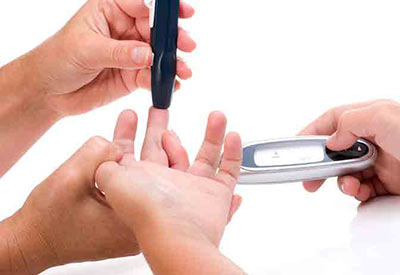
Being diagnosed with diabetes can be terrifying at any age.
While the media’s efforts have improved in recent years, there is still a long way to go toward changing the public’s perception of diabetes. Great strides have been made in diabetes care and people with Type 1 and Type 2 can live long, healthy lives.
Part of the perception problem is the result of the umbrella term “diabetes,” which covers vastly different types of the disease. A simple explanation is that Type 1 diabetes is an autoimmune illness that can occur at any age but most often is diagnosed in children and results when the pancreas stops producing insulin. People with Type 1 must inject insulin into their bodies to survive. Type I is one of the most common diseases of childhood, and the incidence of Type I in children under 5 has doubled in the past five years. Type 2 diabetes occurs when insulin is not being produced properly in a person’s body, and, in most cases, can be managed with lifestyle changes.
“When we got the Type 1 diabetes diagnosis for our 2-year-old son, we were devastated, overwhelmed and felt isolated even from family and friends. Our life had to become so regimented to make sure our son’s health care was at the optimal level we could provide. We changed our lives so Ethan could have the most normal life that we could provide for him so he didn’t feel like he was different,” said Sharon Kantala.
“We have a team approach to diabetes that includes a diabetes educator, a nutritionist and a social worker because mental health is so important for the child and the family. A diabetes diagnosis affects the whole family. We also have a care coordinator who offers support to families when their child is first diagnosed. Her job is to educate them on a ‘new normal.’”
Thankfully for parents such as Sharon, Charleston is home to the Medical University of South Carolina’s Department of Pediatrics and its Division of Pediatric Endocrinology. Deborah Bowlby, MD, MSc, is the division chief and also the medical director of Pediatric Diabetes, and her department sees 100 new cases each year. Of those, 80 have Type 1, 10 have Type 2 and the other 10 are children with cystic fibrosis or steroid-related diabetes.
The community network is essential to managing life with diabetes. Dr. Bowlby said her team works to connect new patients with other families. The department has a Facebook page that is updated with photos, events and news.
“We really try to have support groups gather in fun settings such as a basketball game, jewelry making and community service projects for teens,” said Dr. Bowlby. “Peer to peer learning is incredibly valuable. Kids are much more open to learning about technology from their peers.”
Working closely with schools is another important aspect of their work. Dr. Bowlby’s team includes a liaison who communicates with schools directly to offer education and support, and the Charleston County School District has a diabetes educator who serves as a resource for all school nurses in the district. Parents such as Sharon say this support is essential.
“We muddled through life until he got to kindergarten and were excited to start a new chapter but nervous the school would not know how to care for Ethan,” she said. “We just finished the second nine weeks of kindergarten, and I have to say I’m very happy with how it’s going. Ethan is thriving in school and gaining independence with his diabetes. We have two wonderful teachers that watch over Ethan each day and support him to reach his greatest potential.”
A great way to connect with the diabetes community is through two local events that have seen tremendous growth in the last few years: the annual JDRF walk on Daniel Island and the Abby’s Friends Charity Golf Classic and Gala.
Paige Kuehmeier, one of the founders of the JDRF walk and mother of a child with Type 1 said: “The walk in Charleston has been a grass-roots effort. It was founded by a small group of four or five T1D parents/families. In the beginning, we asked the stores and businesses we frequented as well as MUSC for support. We’ve asked family and friends to come and leaned on a few JDRF national partners for support, and the good news is that these groups came and helped and inspired us to do more. It’s been a gradual build, and now there is momentum.”
The JDRF Walk raises funds to improve lives and works to find a cure for this chronic disease. It is equally a day of hope and celebration for all the work that JDRF and its supporters have done to advance its purpose. The sense of community on walk day is strong. So many families don’t know others with Type 1 and feel isolated, and the walk helps them know they are not alone in their struggles and victories.
Abby’s Friends is an all-volunteer, not-for-profit organization dedicated to raising awareness of Type 1 diabetes and money for research. Founded by John and Kendell Sutterlin, whose daughter Abby was diagnosed when she was 4 years old, the organization has raised more than $1 million since 2007. All proceeds go to assist other nonprofit organizations that focus on Type 1 diabetes.
Camps are another great resource for families with diabetes. South Carolina has Camp Adam Fisher and Camp Sweet Escape, which offer a variety of activities, including horseback riding, zip lining, swimming, canoeing, arts and crafts, and more. They also provide the experience of being surrounded by peers who understand what it’s like to live with diabetes – and that is priceless. For parents, these camps offer a much-needed break from the demands of managing diabetes and the assurance of knowing their child is safe.
Transitioning from childhood to adulthood is challenging for anyone and can be particularly daunting for kids with diabetes.
Dr. Bowlby’s team at MUSC runs a Diabetes Transition Program that begins at age 15 and helps patients take more responsibility for their care. She said the program is “patient and family focused,” and they work to make sure patients have a voice in their care.
“The future is bright,” said Dr. Bowlby.
In addition, great strides are being made with technology such as Continuous Glucose Monitors, which help patients understand the trends in their blood sugar management. This tool can ease parents’ anxiety and fear when it comes to swings in their child’s blood sugar levels. Insulin pumps now are more user-friendly, and the next step is a closed-loop system that will revolutionize diabetes management.
A diabetes diagnosis is scary, but, with a team of experts such as those at MUSC and a variety of support networks, parents and children with Type 1 diabetes have access to excellent resources in the community – and that makes all the difference.







